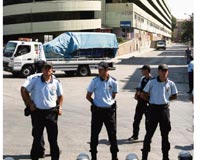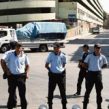
TURKISH POLICE FOIL MASSIVE BOMB ATTACK IN ANKARA
Publication: Eurasia Daily Monitor Volume: 4 Issue: 168
By:

The discovery of a vehicle packed with explosives in the center of Ankara has once again raised questions about Turkey’s vulnerability to a mass-casualty terrorist attack.
On the morning of September 11, two police sniffer dogs identified explosives in a Mercedes panel van in a multistory parking lot in the Kurtulus neighborhood of Ankara. The precise details of how the van was detected remain unclear, although several Turkish newspapers quoted police officials as saying that it was found during routine searches in the run-up to the anniversaries of the 9/11 attacks on the United States and the September 12, 1980 military coup in Turkey (Zaman, Hurriyet, Yeni Safak, September 12).
The van was subsequently found to contain an improvised explosive device (IED) consisting of ammonium nitrate, sodium nitrate, TNT, around 20 small LPG bottles and several containers of what the Turkish police described only as “explosive materials.” There are conflicting reports about the size of the IED, with figures ranging from 300 kilograms to 580 kilograms (Sabah, NTV, CNNTurk, September 12). Turkish officials said that they had also found three cell phones in the van, suggesting that the IED was primed to be detonated remotely. The assumption is that the van had been deposited in the parking lot prior to being driven to its eventual target, although there is currently no indication of what the target was going to be (Hurriyet, Milliyet, September 12).
On the evening of September 11, the governor of Ankara announced that the design of the IED was similar to devices used by the separatist Kurdistan Workers’ Party (PKK) in southeast Turkey (CNNTurk, September 11). However, the PKK has no record of using such large vehicular IEDs. Although it has conducted a number of bombing campaigns in western Turkey, these have mostly comprised small IEDs based around A4 or C4 plastic explosives.
However, the IED found in Ankara is also similar in composition to the devices used in the four al-Qaeda attacks in Istanbul in November 2003, which killed 63 people. However, in Istanbul the IEDs contained an average of 2,350 kilograms of explosive materials and were activated by a simple switch controlled by a suicide driver.
There has been considerable speculation that the van found in Ankara was going to be used in an attack to commemorate the attacks of 9/11, probably against a foreign target in the city. Turkey has a long history of indigenous Islamist violence, particularly in the underdeveloped east and southeast of the country. However, indigenous groups have traditionally avoided directly targeting the Turkish state. Even the al-Qaeda bombings in Istanbul in November 2003 were directed primarily against Jewish and British rather than Turkish targets, although a large number of Muslim Turks were also killed.
The November 2003 bombings were the first time that a transnational organization had staged an attack in Turkey. Previously, Turkish security forces had ignored Turkish radicals traveling abroad to join the international jihad on the grounds that they did not pose a threat to domestic security. However, the situation changed with the Istanbul bombings. Radicals with links to transnational groups such as al-Qaeda are now amongst the main targets of the Turkish security forces. At least four other mass casualty attacks in Turkey are believed to have been thwarted since November 2003. As a result, many al-Qaeda sympathizers have found it easier to travel across the border to join the insurgency in Iraq rather than try to plot attacks inside Turkey.
Nevertheless, even if the van found in Ankara turns out to be linked to an al-Qaeda affiliate in Turkey, there will inevitably be no shortage of conspiracy theories to try to shift responsibility elsewhere. Many Turkish Islamists are not only opposed to the use of violence against civilians but refuse to accept that any God-fearing Muslim could be involved. The result has been the creation of a culture of denial that has allowed the small number of advocates of violence to operate on the margins of the Turkish Islamist movement with relative impunity, usually under cover of Islamic charities and foundations.
On the morning of September 11, before the van in Ankara had been discovered, many Islamist journalists wrote articles devoted to the anniversary of the 9/11 attacks on the United States in which they repeated conspiracy theories and attempted to shift responsibility away from the perpetrators and to what they regard as the anti-Muslim violence of the subsequent U.S.-led war on terrorism.
“New pieces of information keep surfacing about this act of terrorism,” wrote Ali Bulac, in Today’s Zaman. “These pieces, each of which is surprising, tell us that the event in question is not ordinary at all and that it was organized and perpetrated as an abstruse and ‘deep’ operation. It will never be clear who carried out the September 11 attacks. Therefore, it is more beneficial to dwell on the results rather than on the detective side of the incident” (Today’s Zaman, September 11).




